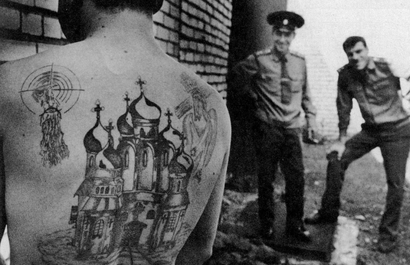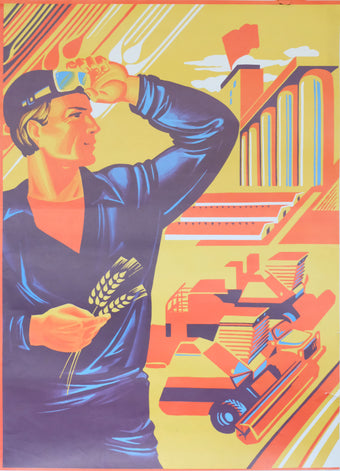Labour’s Legacy
From Fields to Factories: The Glorification of Labor in Soviet Art
The hammer and sickle were the tools of the Soviet worker and peasant. But building a strong communist state demanded more than just tools. Labour was no longer merely a means of survival, but a tool for societal transformation. The state, with its rigid plans and relentless propaganda, sought to reshape every aspect of a worker's life, aiming for unprecedented levels of productivity in the service of a Socialist utopia.
Building an Industrial Powerhouse
After seizing power in 1917, the Bolsheviks embarked on a rapid transformation of the Soviet Union into an industrial powerhouse. To achieve this, they instituted strict control over the workforce, restricting worker freedom to choose jobs and workplaces. Wages, work hours, and even "voluntary" work were highly regulated. A modern, industrial USSR would have economic independence from capitalist countries. Stalin articulated the sense of urgency: "we are 50–100 years behind the advanced countries. We must make good this distance in ten years. Either we do it, or they crush us."
The Five-Year Plans, launched in 1928, became the cornerstone of Soviet industrial transformation. The Soviet government financed its industrialisation efforts through taxation, forced labour and through the sale of priceless artworks from the Hermitage museum. The results were immediate and dramatic. Millions of citizens worked around-the-clock, building factories, power stations, dams, canals, railways, and metro stations – often working in three shifts and largely by hand. A staggering 1,500 major industrial facilities were constructed between 1930 and 1932. These included iconic projects like DneproGES, a hydroelectric dam, and large steelworks in cities like Magnitogorsk. The crowning achievement was the opening of the first Soviet metro line in 1935, the 11km long Moscow Metro.
To address the growing demand for skilled workers, the Soviet Union expanded its higher education system, emphasising technical fields. In parallel, universal primary education was introduced in 1930, with mandatory seven-year schooling in cities. These educational reforms helped produce around two million skilled specialists between 1928 and 1937. This focus on advanced training enabled the Soviet Union to master new technologies, a notable example being tractor production. By 1932, the Kirov Plant in Leningrad began producing the "Universal" tractor, the first Soviet tractor. Over the next ten years, more than 700,000 tractors were produced, accounting for 40% of the world’s production. Alongside this economic revolution, Socialist Realism paintings and propaganda posters celebrated the emergence of this industrial might. They glorified the physical strength and determination of labourers, depicting them as heroic figures building a brighter future. Giant factories and dams became common subjects, emphasising the raw power of Soviet advancement.
By 1932, Stalin declared the first Five-Year Plan a success, touting a 108% increase in heavy industry output and decreased reliance on imports. Official reports celebrated the Soviet Union's newfound status as a "firmly industrial" nation with heavy industry assets nearly tripling between 1928 and 1933. This rapid growth propelled the nation to become the world's second-largest industrial power, trailing only the United States. However, this progress came at a devastating cost. While imports declined, signalling a shift toward economic independence, the standard of living for Soviet citizens deteriorated sharply. By the end of 1929, rationing was extended to almost all food products.



Collectivisation: The Human Cost of Progress
The Soviet Union's collectivisation drive was launched in 1928, and promised an agricultural revolution. Driven by deep ideological mistrust of private farming, the Communist Party saw collectivisation as the solution. Lenin claimed that "small-scale production gives birth to capitalism". To fuel Stalin's ambitious heavy industrialisation program, private farms would be merged into state-controlled collectives. This would boost production to feed the growing urban workforce and generate surpluses necessary to pay for machinery imports through grain exports.
Some peasants initially joined collectives, lured by promises of better tools and conditions. Collectivisation was swift: 7.5% of farms were collectivised in October 1929, the figure jumped to 52.7% by February 1930. By 1936, about 90% of Soviet agriculture was collectivised. But, the state's unrealistic quotas and mass seizures of livestock devastated production. In 1928, there was a 2-million-ton shortfall in grains. Livestock numbers plummeted – cows alone fell from 33.2 million in 1928 to 24.6 million by 1950. Agricultural productivity lagged well behind the West, with Soviet farmers producing only about 10% of their American counterparts'.
Peasants who opposed collectivisation were labelled enemies of the state, and forcibly removed from their land, taxed into ruin, or deported to labour camps in Siberia. Stalin saw collectivization as a way to eliminate the 'kulaks', the more prosperous farmers, who he viewed as a threat to socialist ideals. He accused them of hoarding grain and imposed impossible quotas. For peasants that were unable to meet their grain quota, they were fined five-times their original quota. In 1929 alone, 5 million 'kulaks' were sent into exile. The state blamed the 'kulaks' for the resulting famine. While Soviet art often celebrated the ideals of collectivised farming, it rarely addressed the harsh realities of its implementation. The suffering caused by famine and forced labour was largely absent from artistic portrayals.
Grain requisitions continued relentlessly, even as millions began to starve. Ukraine, one of the largest grain-producing states in the USSR, was subject to unreasonably high grain quotas. Millions starved, with an estimated 3.5 to 5 million Ukrainians dying. Stalin denied the existence of the famine altogether, banning journalists from visiting collective farms and refusing foreign aid. A black market in human flesh emerged, and police documented cases of children being kidnapped, killed, and eaten. Survivors told accounts of cannibalism, often involving desperate parents eating their own children. At the 1945 Yalta Conference, Winston Churchill is said to have asked Stalin how many perished in the famine. In response, Stalin shrugged and held up 10 fingers, a gesture interpreted as an implicit admission of ten million deaths caused by his collectivisation drive.




The Gulag Archipelago: Forced Labor and Repression
Forced labour was a critical engine driving the Soviet Union's rapid industrialisation plans. To meet ambitious Five-Year Plan goals, the government needed a vast and readily available workforce. Established in 1930, the Gulag (Glavnoye Upravleniye Lagerey) was a sprawling network made up of 30,000 camps, scattered across the Soviet Union. The official story presented the Gulag as a rehabilitation program for criminals. Reality, however, was far darker. Political dissidents, minority groups and anyone deemed an "enemy of the people," were vulnerable to being sent to the Gulags.
The Gulag system was deliberately isolated. Communication between camps was virtually forbidden, and the wider society wasn't allowed to even mention their existence. Prisoners were forced to work long hours in dangerous and often backbreaking jobs, from mining and logging to massive infrastructure projects like the White Sea-Baltic Canal. Inadequate food, shelter, and non-existent medical care led to countless deaths from exhaustion, disease, malnutrition, and outright execution. An estimated 14 to 18 million people entered the Gulag between 1929 and 1953, with more than 1.6 million dying in its camps. Approximately 20% of the prisoners were freed each year, but not because they were rehabilitated, but because those prisoners were too weak to continue working or were suffering from incurable diseases.
World War II brought a new wave of forced labour in the Soviet Union. Soviet authorities, not party to the Geneva Conventions, disregarded prisoner of war protections and sent captured soldiers and civilians from Germany and Eastern Europe to toil in the Gulag camps. This forced labour was seen by the Soviets as war reparations for the devastation inflicted by Nazi Germany. However, it proved inefficient. Many Germans, particularly women and older men, weren't physically capable of the brutal work demanded. With a death rate of 24%, the program was ultimately short-lived. Repatriation began as early as 1945, with most released by 1950, motivated by a desire to rebuild diplomatic relations with West Germany.
The rise of the Cold War sparked a new kind of exploitation: the race for German scientific expertise. The US initiated Operation Paperclip, bringing figures like Wernher Von Braun to work on their nuclear and space programs. The Soviets mirrored these tactics, forcibly deporting hundreds of German specialists in 1946. While these specialists received better treatment than Gulag labourers, their work remained forced. Helmut Gröttrup, a German engineer who worked on the V-2 rocket program under Von Braun, was compelled to work on Soviet missile development. Discharged in 1950, Gröttrup and other scientists were held in the USSR for over a year to prevent timely intelligence leaks to the West. Gröttrup eventually escaped to West Germany in 1953, aided by Western intelligence agencies.
Through forced labour, relentless propaganda, and a disregard for human life, the Soviet Union achieved unprecedented industrial growth. The stark contrast between artistic idealisation and lived experiences emphasises the power of art to both inspire and deceive. The suffering of millions remained unseen, their stories buried beneath the propaganda machine.

Bidding for Glasnost: The Sotheby's Auction that Transformed Soviet Art
























